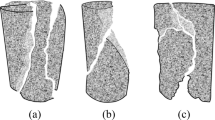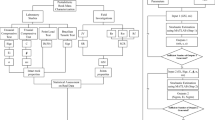Abstract
Spatial variance of rock properties is an important characteristic of rock which addresses the heterogeneity of mechanical and physical properties and their effect on underground mining. Assessing spatial variance can be useful for both locating potential difficult grounds and performing reliability analysis in the mining support system. This study shows a microscale numerical model for rock material based on continuum mechanics. To consider the spatial correlation factor of mechanical properties in realistic rock mass, this study introduces a spatial correlation concept into the traditional type III extreme value distribution model. Based on the improved microscale random model, we conducted a series of numerical uniaxial compressive tests and one longwall mine model to investigate the progressive failure of rock. The results show that spatial correlation factor can significantly affect the load-deformation curves and fracture patterns. The spatial variance model was applied to a longwall mine that included several cutting sequences to observe the influence of the spatial variance on roof behavior. The cohesion and friction random fields induced failure that propagated randomly through the immediate roof in different entries. The results showed that the spatial variance provides an accurate prediction of erratic roof falls in coal mines.
















Similar content being viewed by others
References
Amusin BZ (1979) Mechanical characteristics of rock in place in analytical calculations on rock pressure phenomena in workings. J Min Sci 15(6):551–556
Bieniawski Z (1968) The effect of specimen size on compressive strength of coal. Int J Rock Mech Min Sci Geomech Abstr 5(4):325–326
Bieniawski ZT (1978) Determining rock mass deformability: experience from case histories. Int J Rock Mech Min Sci Geomech Abstr 15(5):237–247
Chen Q, Seifried A, Andrade JE, Baker JW (2012) Characterization of random fields and their impact on the mechanics of geosystems at multiple scales. Int J Numer Anal Methods Geomech 36(2):140–165
Einstein HH, Baecher GB (1983) Probabilistic and statistical methods in engineering geology. Rock Mech Rock Eng 16(1):39–72
Einstein HH (1993) Modern developments in discontinuity analysis–the persistence–connectivity problem. In: Rock Testing and Site Characterization, pp 193–213
Fang Z, Harrison JP (2002) Development of a local degradation approach to the modelling of brittle fracture in heterogeneous rocks. Int J Rock Mech Min Sci 39(4):443–457
Gao D, Mishra B, Xue Y (2020) Numerical simulation of laboratory strength tests using a stochastic approach. Min Metall Explor 37:709–716
Griffiths DV, Fenton GA, Lemons CB (2002) Probabilistic analysis of underground pillar stability. Int J Numer Anal Methods Geomech 26(8):775–791
Haldar, A. (2000). Probability, reliability and statistical method in engineering design
Hoek, E., & Brown, E. T. (1980). Underground excavations in rock. No. Monograph
Hoek E (1983) Strength of jointed rock masses. Geotechnique 33(3):187–223
Kim K, Gao H (1995) Probabilistic approaches to estimating variation in the mechanical properties of rock masses. Int J Rock Mech Min Sci Geomech Abstr 32(2):111–120
La Pointe PR, Hudson JA (1985) Characterization and interpretation of rock mass joint patterns, vol 199. Geological Society of America
Ledvina C T (1991) Geostatistical inference and exploration of coal mine roof strata. Diss. Northwestern University
Mathworks, User Guide (1998) User’s guide of the mathworks: generalized extreme value distribution
Potvin Y, Dight PM, Wesseloo J (2012) Some pitfalls and misuses of rock mass classification systems for mine design. J South Afr Inst Min Metall 112(8):697–702
Priest SD, Hudson JA (1976) Discontinuity spacings in rock. Int J Rock Mech Min Sci Geomech Abstr 13(5):135–148
Recio-Gordo D, Jimenez R (2012) A probabilistic extension to the empirical ALPS and ARMPS systems for coal pillar design. Int J Rock Mech Min Sci 52:181–187
Salamon MDG, Munro AH (1967) A study of the strength of coal pillars. J South Afr Inst Min Metallurgy 68(2):55–67
Scovazzo, V. A. (1992). A practitioner’s approach to pillar design. In Proceedings of the Workshop on Coal Pillar Mechanics and Design, 33rd U.S. Symposium on Rock Mechanics., U.S. Bureau of Mines: 277–82
Soltani A (2015) Analysis of the ARMPS database using FLAC3D; a pillar stability comparison for room and pillar coal mines during development. Master’s Thesis. University of Kentucky
Peng SS, Dutta D (1992) Evaluation of various pillar design methods: a case study. In proceedings of the workshop on coal pillar mechanics and design, 33rd U.S. Symposium
Villaescusa E, Brown ET (1990) Characterizing joint spatial correlation using geostatistical methods. In Rock joints, Balkema Rotterdam, pp 115–122
Weibull W (1939) A statistical theory of the strength of materials. Ing. Vet. Ak. Handl
Yegulalp TM, Kim K (1992) Statistical assessment of scale effect on rock properties using the theory of extremes. Trans AIME 294:1834–1834
Yegulalp TM, Kim K (1994) Statistical assessment of scale effect on rock properties using the theory of extremes. Trans-Soc Min Eng AIME 294:1834–1837
Yu YE, Mostyn GR (1993) Spatial correlation of rock joints. In: Proc of the Conference on Probabilistic Methods in Geotechnical Engineering, pp 241–255
Funding
This work was supported by the National Institute for Occupational Safety and Health (grant numbers 200-2011-40676, 200-2016-92214).
Author information
Authors and Affiliations
Corresponding author
Ethics declarations
Conflict of Interest
The authors declare that they have no conflict of interest.
Additional information
Publisher’s Note
Springer Nature remains neutral with regard to jurisdictional claims in published maps and institutional affiliations.
Rights and permissions
About this article
Cite this article
Gao, D., Mishra, B. Modeling Spatial Variance and Investigating the Effects of Variability on Intact Rock Strength and Stability of Entries in a Longwall Mine. Mining, Metallurgy & Exploration 37, 1557–1570 (2020). https://doi.org/10.1007/s42461-020-00258-x
Received:
Accepted:
Published:
Issue Date:
DOI: https://doi.org/10.1007/s42461-020-00258-x




